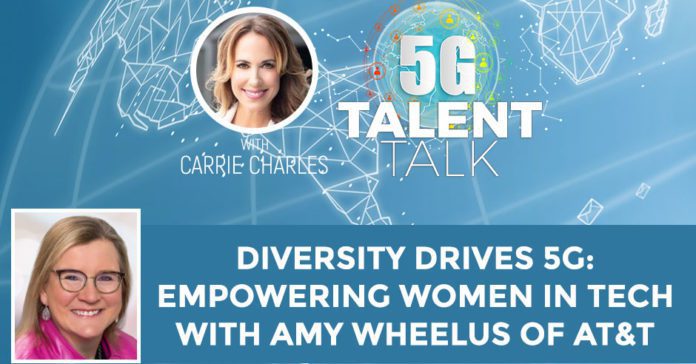While gender inequality is present in every industry, it seems particularly prevalent in the male-dominated tech world. Women continue to leave the tech industry at unprecedented rates with the pandemic fueling the fire. In our new world of work, how do we encourage more women to enter tech fields — and stay? How can companies design a culture that supports and empowers women? Listen to our host Carrie Charles and guest, Amy Wheelus, as they dive deep into the “why and how” behind the gender gap challenge. In this engaging episode, Amy shares valuable tips for leaders to navigate our new talent landscape, promote more women to leadership roles and inspire younger generations to follow in their footsteps.
—
Watch the episode here
Listen to the podcast here
Diversity Drives 5G: Empowering Women in Tech with Amy Wheelus of AT&T
I have a wonderful guest with me, Amy Wheelus. She is the Vice President of Architecture and Strategic Planning for AT&T, the Consumer business unit. Amy, thank you so much for joining me.
Thank you, Carrie. I’m so glad to be here.
Amy, let me brag a little bit. Amy was a 2019 Fierce Telecoms Rising Star and in 2021, was named one of the top women in tech by the Dallas Business Journal. In fact, when I was doing some research on you, there was a lot of other stuff that came up too. You are involved in so much and have received awards and so many accolades. I’m thrilled to have you on the show. Amy, I want to start with your professional journey. How did you get to where you are now?
It’s been a long journey but it has flown by. I’ve been with AT&T in many different roles over the past 31 years. I am an engineer by training. I’m a Ramblin’ Wreck from Georgia Tech. (I have to put in that plug for my school.) I started in our network organization and have moved around. I’ve done everything from building buildings to starting new businesses.
One of the keys was continually learning and taking on new roles and new challenges when they came about. That’s allowed me to grow as a technologist and grow as a leader. I’ve enjoyed that ability to do that across AT&T as I’ve moved through my career.
Tell me about your role, a little bit about what you do.
I am in our Consumer business unit. I have responsibility for our architecture and our strategic planning. “Where are we going from a technology perspective?” “How are we changing and transforming our business?” We are in the midst of one of the most aggressive transformation efforts I’ve ever been a part of. We’re transforming the entire consumer stack – everything from our billing systems, all the way up through how our customers experience their interaction with AT&T. We’re doing all that at the same time that we’re rolling out 5G and turning up new technologies. It’s a challenge but it’s exciting.
What does 5G mean for the customer? I know we talk about it all the time. We hear it. We have commercials. We read. There’s so much information on 5G. What is it beyond video games and faster downloads?
One of the keys to leadership was continually learning and taking on new roles and new challenges when that came about.
If you think about it, every new generation of connectivity has changed and created new innovative ideas. If you go back in history, you went from the telegraph to the telephone, from analog to digital, from wireline to wireless and now 3G, 4G and 5G. 5G is setting the stage now for revolutionizing how we interact with each other. If you think about the increased speed and the decreased latency, that’s all the geek speak about what 5G is. It is about laying a foundation for how we change the experience. 5G’s impact is going to be experiential and drive an unrivaled interactive experience.
It’s experiential. Can you give me an example?
I’m a Star Trek geek. If you think about Star Trek and the holographs that have been on our TV, we’ve been watching that technology for years. That technology is now real. In 2020, we proved that technology. During COVID, we were able to transform the sports interview using holographic capabilities, powered by 5G, in the 2020 NBA playoff bubble in Orlando.
I think another thing there, if you think about it, one day deployed family members will be able to spend Thanksgiving at home with their loved ones or other people across the country and feel like they’re in the same room with them. You won’t be able to touch them, but you’ll be able to be there and feel like they’re there and be a part of it much better than just a flatscreen like we’re doing today.
I got chills. Even the thought of that, and I love what you said, that 5G is going to bring us together. When people think of technology, sometimes they feel that it’s a disconnect but 5G is all about connecting us. What are some of the opportunities for consumers with 5G and also some of the opportunities to monetize it?
Beyond the super-fast downloads and low latency, it’s those experiences. “How do you do that in places like a high-density stadium?” The 5G technology is changing our in-stadium connectivity. Right now, you watch the game, you see a big screen but in the future, if you think about it, you could be standing there beside LeBron, having that very fast capability to be reacting and it’s like you’re on the field with him.
Let’s use Tom Brady because I live in Tampa. Will I have special glasses I put on? I have the experience and I’m right down there in the field. I became a football fan when Tom arrived.

In the past, if you were in a stadium or a big event place, and you were trying to Snapchat or text or upload to Twitter, all those uploads get all bogged down and you get frustrated and you want to share it with everybody you could. The speed and the capacity that 5G will allow are going to make that even better. You put on a pair of AR glasses and you are able to choose the view that you’re seeing. Maybe you can have the view of Tom Brady. You’re Tom Brady standing back there and as he moves his head, you’re seeing what he sees. That 300-pound lineman comes in and is about to tackle you. I’m not sure I want that, but you can personalize how you replay things.
Anything you can dream up, those things will be available. Even to take it out of the sports realm, maybe in the future people won’t need to have an actual piano but they can put on the AR glasses and learn to play piano on their desk because the piano is superimposed there and you’re able to do that. Think about all the things within education that can be enabled.
I was a part of a tech challenge and got to help judge in 2020. The winner of that tech challenge was working on synthetic humans that are powered by 5G technologies. It’s another fancy word for a holograph, but in the education space. We have a shortage of teachers. “How do you create the ability to put a teacher in multiple places at the same time?”
We could go on and on. I love geeking out here with you. Let’s switch gears a bit. I know one of your passions is women in tech. I was reading in 2021. Still, we have an issue. Only 25% of jobs in tech are held by women. In your view, what are the challenges with getting women into tech and also keeping them there?
We have got to help women believe that they can thrive in the tech industry. I think that one of the biggest challenges is keeping them there. We’re seeing the number of women graduating with tech degrees moving up. We’ve seen an increase. It’s not at parody yet but it is increasing. If you look into the future 5 – 10 years into their career, the number leaving their tech jobs is huge. I saw a stat out of Accenture in 2020 that said 50% of women leave their tech jobs by the age of 35. We all know that there are a lot of reasons for that. Women leave to be moms or because they don’t see themselves thriving. We have to showcase more women in technology.
Little girls need role models that they want to be like. I didn’t know a woman engineer until I got to Georgia Tech. Even then, the ratio of men to women was 8 to 1 when I got there. It’s now a lot better than that, but it’s still at a 2 to 1 ratio. I have a group of friends that I was very close with when I was at Georgia Tech and if I look now many years into our careers, only 3 out of 20 stayed in the field through the whole career.
It’s a small sample but that’s an 85% dropout rate. We have to be better about figuring out how to keep women in the workforce and that’s going to mean, “what programs we can create to help them re-enter?” “If they want to take some time off to have kids and be with their kids when they’re little, how do we help them retool and re-enter?” “How do we help them see the technology industry is somewhere they can thrive?”
You hear the work-life balance. It’s never going to be perfectly balanced. What it has to be is work-life integration.
Amy, I read something which gave me a lot of hope. There was a study done in 2021. It’s the TrustRadius Third Annual Women in Tech Report. They found that 74% of girls express a desire for a career in STEM fields. My daughter is a STEM major. Girls are expressing a desire but it’s not translating into tech fields and staying inside of the tech field. I see that there’s a lot of work there that needs to be done. I agree with you.
The COVID pandemic has been so difficult for women. Millions of women have left the workforce. It’s been especially difficult for women in tech. I was reading a bit with this same study. Since the pandemic began, women in tech have been working long hours and have taken on more responsibilities at work. This is 43% said this compared to 33% of men. The word burnout is being used to describe women in tech right now. What are your thoughts on how the COVID pandemic has affected women in tech?
I think in that same study that you read, it also said that women are nearly twice as likely as men to have lost their jobs or been furloughed due to the pandemic. It’s a double whammy. The ones that stayed are working harder, longer and burning out. There were more women who lost their job than men as well. One of the things that we’ve been focusing on within the team that I’m a part of is trying to reach out and make sure that people know that we know they have to figure out how to balance.
The caregiving duties largely at home, in many cases, fall on the woman in addition to their career responsibilities. We’re trying to help our women in technology understand that it’s okay if at lunchtime you need to go to the grocery store because that works better for your schedule. That’s fine. I’ve always thought about work-life balance. It’s never going to be perfectly balanced. What it has to be is work-life integration. How do I integrate my work and my life and make them both successful?
I had a conversation with one of my close friends who’s been in the technology industry for a long time. She’s been working at home and said, “I rode my Peloton. I had a meeting get canceled and decided I wanted to ride my Peloton but I feel guilty.” I’m like, “Why do you feel guilty?” I said, “What did you do at lunch?” She said, “I ate lunch at my desk.” I said, “If we’d been in the office and you and I would have gone to lunch, we would have probably talked a little bit of work but we would have talked a lot, not about work and had a downtime. You don’t have that opportunity working from home, so you took a break and you rode your Peloton. Your energy level is higher. You’re taking care of yourself. Your head’s probably clearer. That’s all benefit. We, as women, tend to feel guilty and we need to stop doing that.
That was strong. I believe that. It’s a mindset shift and not just a mindset shift for leadership and Corporate America. It’s a mindset shift for us as women. I know that AT&T has some new benefits and programs. I think it would be important for other business leaders to hear that and maybe get some ideas on how they can retain women.
One of the things that we did was we introduced three weeks of paid caregiver leave to navigate the predictable and unpredictable moments of caring for a child or other family member. Many of the people that are working in the workforce are balancing childcare and elder care all at the same time. I’m going to throw a plug into this one as well. It’s your other family members but also your framily. That’s my word of the friends that have become family.

I’m single and I have other single friends. When you need somebody to take you to the doctor or pick you up from the doctor, you got to have somebody to call on and caregiver leave allows for that. Another thing is that we launched a new benefits program around emergency backup care for children and aging parents. It helps with locating that emergency backup care. There’s a hotline that helps you be able to locate and get that resource when you need it.
There are times when you can’t take off or you feel like you can’t and need that emergency backup care.
For our new or expecting parents, we’ve added four extra weeks to our paid parental leave for a total of twelve weeks. We also have access 24/7 to virtual coaches and self-paced courses for things like infant sleep schedules, adoption, how to eat healthily, all of those different things. Some cool programs that help us integrate our work and life better.
One of our employee groups, women of AT&T Dallas Chapter, launched a virtual bi-weekly happy hour series. It’s a virtual series but it’s focused on helping members maintain their health and wellness, offering stress relief tactics and mitigation ideas. It’s creating that social community that we have to be intentional about. In a world where everybody’s working remotely, you have to be intentional about creating those interactions.
There are definitely some silver linings in the pandemic. I know you’ve mentioned some wonderful programs from AT&T but what else have we learned through this pandemic and in 2020 that led to positive changes for women in the workplace?
My organization is about 95% virtual workers. Prior to the pandemic, we were probably 30% virtual workers. We have allowed them the ability to work from home. We still have times when they come into the office. We’re a software development company or organization. Sometimes you need to get together in a room with a whiteboard and create ideas.
We’ve allowed them that flexibility. It gives them time back in their day to help manage and interconnect with the people that they care and love about. For me, personally, I think that’s a great thing that we want to keep going forward. We also are more aware of the need for social interaction. I think before, it happened organically because we were around people.
You stopped at the water cooler and talked to them or the coffee machine but now I think we understand that need for connection and we’re more intentional about it. I don’t want us to forget that and lose sight of that. I think that will help women. We’re an unusual organization within AT&T in that we have 5 out of 9 vice presidents in the Consumer Technology Platform organization for women, which is a huge percentage. It’s cool.
We have got to help women believe that they can thrive in the tech industry.
One of the things we started during the pandemic was a quarterly Women of Technology (meeting). It’s an hour and we have no agenda. We usually get on the call, have about 300 people on it and take the conversation where it goes. It’s a way for us to connect and be able to be there and open up. It’s an open mic session. We’ve had tears and cheers. It’s been good. I don’t know that we would have thought about doing that had the pandemic not happened and we hadn’t seen the need to try to connect.
I’m sure there are many more positive silver linings that have come out of this pandemic for women. I want to talk a little bit about women in leadership. What you said is unbelievable, that 5 out of 9 vice presidents are women in your organization. That’s fantastic. In the same study and you may have the same study right in front of you, I see that nearly 80% of women in tech said, “Promoting more women to leadership roles would better support women in the field,” and 72% said, “Providing mentorship opportunities,” and 64% said, “Flexibility, mentorship.” It’s exactly support and brings people together.
The list goes on and on but I think that what we want to look at and the highlight is that when there are women in leadership, we, as women, feel confident that we’ve got a shot. When there are no women in leadership or few then we don’t see that path. We could potentially go someplace where we have that. How do we promote more women to leadership roles in tech? Why is this an issue? It seems to me like it would be easy.
In my direct peer group, it’s a great ratio. When I go to industry meetings, it’s not like that. One of the things I challenge all of our vendors is that they better keep improving that ratio of women in the room. Many times, we’ll go to a meeting with a vendor or I’ll go to an industry forum meeting and there are very few women in the room. I’m 1 of maybe 2 or maybe sometimes the only one.
Women need to see women in leadership roles. They need them as role models so that they have something to aspire to. For us in the technology industry, the women, those of us who are in leadership roles, have to become advocates. We have to help mentor them and lift them up. One of the things we’ve got to do is we’ve got to be willing to put them in a role that stretches their ability.
At the same time, we’ve got to give them the grace, support to fail and get up and try again. No one ever achieves anything great without failing. Read any entrepreneurial or leadership book and everybody talks about the failures they’ve had. As women, we have a tendency to be very risk-averse because there’s no margin for error when there are so few opportunities and many fighting for those few opportunities.
As leaders, we’ve got to support that and say, “I’m going to take a chance on this person and give them the opportunity to mess up. I’m going to lift and help them get back up and try again.” Help them make the decision to say, “I’m comfortable here but let’s go move into some uncomfortable space,” because I think that’s important.

Amy, what helped you rise to the top?
I had many tremendous mentors along the way, both men and women and some role models that I watched, observed and mimicked. That’s been cool. Some of them are our leaders in the telecommunications industry. Kris Rinne is in the WITI Hall of Fame and sits on the Board of Ericsson. She was the CTO of Cingular. She’s one of the mentors that I’ve looked up to.
I happened to meet her because I was tapped on the shoulder and (was told), “I want you to go work on this special project.” I went and worked on that special project and got the opportunity to sit at her table. I was working for somebody else but she was the executive leading the work. I was able to watch and learn from her. She made a difference in my life.
Another one is Bill Hogg, who was in our Cingular and AT&T organization and led our network organization. He pushed me on things like, “Amy, you got to work on your poker face because what you see is what you get.” That has helped me move along.
I love sports. I grew up playing sports. I was an athlete. I’m an armchair athlete now. That instilled in me a belief that we’re better together.
A team is only as good as the weakest link and we all have roles to play. If somebody doesn’t do their job then something doesn’t get done right. That teamwork has helped me move along in my career and be a good team and corporate player. I think you have to do those things. When you’re trying to do it all by yourself, you fail. When you’re trying to do it just for yourself, you fail.
Amy, you are a tremendous leader. What would you say are your top three leadership principles?
I’m going to give you four. One is to work hard and play harder. With that, give 100% and be present where you are. If you’re working, be present and give 100% of that. If you’re not working or you’re playing, you go give 100% to that. It’s hard because we’re connected to these things all the time. We’ve got to take that time to play hard, disconnect and recharge. As a leader, we enable that.
We should be aware of the need for social interaction.
The second one is to respect our differences. Everyone contributes value. You debate ideas but you’re supporting the decisions. You’ve got to be respectfully challenging the norm. The norm is the norm. We can get complacent, but you’ve got to challenge it. You’ve got to do it respectfully. We have to learn from each other.
The last two were quick. Be transparent, upfront, and open. The bad news is not like fine wine. It does not get better with age. You’ve got to do root cause analysis when something goes wrong. Learn from it. You do a root cause analysis, not to point fingers but you do that root cause analysis to learn from it, so you don’t repeat the mistake. You got to share information. Too many people think that information is power and I’m going to keep it all to myself.
The last one is to be accountable, set stretch targets and expect results for you and your team and ask questions.
You could write a book. I feel a book inside you. Earlier in our conversation, you talked about how excited you were. It’s a big challenge, everything that’s going on and what you’re working on but also that you’re so excited. What excites you most about your work?
I think the thing that excites me the most is seeing the team overcome those challenges. There are many days where we’ll walk into a meeting and the team has got this mountain of work to do. We can’t get it all done. We help them work through the problem, work the problem and then they come back, “We figured it out. We’re going to get it done.” Those are the times that excite me – helping see our teams accomplish things that they didn’t even think were possible. That’s what makes me keep coming back to work.
The technology is great and I’ll always love the technology but it’s the people and helping them be successful that excites me about what we’re doing.
Amy, thank you so much for being on the show. This has been fantastic. I’m sure that our audience has gotten enormous benefit from it.
Thank you very much. I appreciate the time to be here.
You take care.
Important Links
About Amy Wheelus

AMY WHEELUS is the VICE PRESIDENT-ARCHITECTURE AND STRATEGIC PLANNING – CONSUMER TECHNOLOGY PLATFORMS with AT&T.
Amy is a natural leader who thrives on the challenges of using technology to enable organizations and people to accomplish extraordinary feats. She starts with the “end in mind” and makes timely decisions from a mix of carefully analyzed facts and an intuitive sense of the bigger picture. Amy thinks strategically while delivering operational results. People listen and follow her as she conveys authenticity and inspires loyalty. Amy believes in the meritocracy of ideas brought forth from a diverse group of people.
In her career at AT&T, Amy has done everything from building buildings to launching new businesses. Since mid-2020, Amy has served as the Vice President of Architecture & Strategic Technology Planning for Consumer after serving as the Vice President of Broadband & Video Systems for the previous 9 months. In these roles, she has been driving the technology transformation of AT&T’s Consumer Technology Platform by radically simplifying and modernizing the business support software systems and operating model.
Previously as Vice President of Network Cloud, Amy led the team that delivered AT&T’s Network Cloud that hosted the 5G Packet Core and the world’s first standards-based Mobile 5G Millimeter Wave Call. Before that, she led the program management of AT&T’s network transformation to software defined networking. Earlier, Amy rose through the ranks of AT&T Labs and Network Operations with responsibilities including program management, transport planning & engineering, and building engineering.
Amy received an MBA from Emory University and a Bachelor of Industrial Engineering from the Georgia Institute of Technology. She serves on the ISYE Advisory Board at Georgia Institute of Technology and on the Advisory Board of the AT&T Center for Virtualization at Southern Methodist University. She is the Board Chair of Tech Titans, a forum that connects the regional technology community of North Texas. Amy serves on the Advisory Board of AT&T’s Advocates for Women in Technology and is an active STEM mentor. In 2021, she was recognized by the Dallas Business Journal as one of the top Women in Technology in North Texas. She was previously recognized in 2019 as a “Rising Star in Telecom” by FierceTelecom.
Love the show? Subscribe, rate, review, and share!
Join the 5G Talent Talk Community today:

